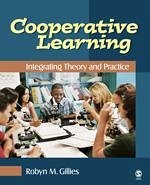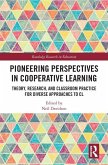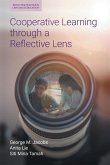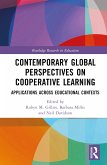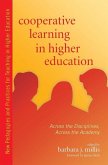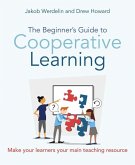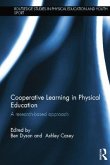- Broschiertes Buch
- Merkliste
- Auf die Merkliste
- Bewerten Bewerten
- Teilen
- Produkt teilen
- Produkterinnerung
- Produkterinnerung
Although cooperative learning is widely endorsed as a pedagogical practice that promotes learning and socialization among students, teachers still struggle with how to introduce it into their classrooms.
Andere Kunden interessierten sich auch für
![Pioneering Perspectives in Cooperative Learning Pioneering Perspectives in Cooperative Learning]() Pioneering Perspectives in Cooperative Learning41,99 €
Pioneering Perspectives in Cooperative Learning41,99 €![Cooperative Learning Through a Reflective Lens Cooperative Learning Through a Reflective Lens]() George M JacobsCooperative Learning Through a Reflective Lens37,99 €
George M JacobsCooperative Learning Through a Reflective Lens37,99 €![Contemporary Global Perspectives on Cooperative Learning Contemporary Global Perspectives on Cooperative Learning]() Contemporary Global Perspectives on Cooperative Learning132,99 €
Contemporary Global Perspectives on Cooperative Learning132,99 €![Interactive Web-Based Education: Interactive Web-Based Education:]() Mai NeoInteractive Web-Based Education:51,99 €
Mai NeoInteractive Web-Based Education:51,99 €![Cooperative Learning in Higher Education Cooperative Learning in Higher Education]() Cooperative Learning in Higher Education42,99 €
Cooperative Learning in Higher Education42,99 €![The Beginner's Guide to Cooperative Learning The Beginner's Guide to Cooperative Learning]() Drew HowardThe Beginner's Guide to Cooperative Learning21,99 €
Drew HowardThe Beginner's Guide to Cooperative Learning21,99 €![Cooperative Learning in Physical Education Cooperative Learning in Physical Education]() Cooperative Learning in Physical Education79,99 €
Cooperative Learning in Physical Education79,99 €-
-
Although cooperative learning is widely endorsed as a pedagogical practice that promotes learning and socialization among students, teachers still struggle with how to introduce it into their classrooms.
Hinweis: Dieser Artikel kann nur an eine deutsche Lieferadresse ausgeliefert werden.
Hinweis: Dieser Artikel kann nur an eine deutsche Lieferadresse ausgeliefert werden.
Produktdetails
- Produktdetails
- Verlag: SAGE Publications Inc
- Seitenzahl: 288
- Erscheinungstermin: 16. Mai 2007
- Englisch
- Abmessung: 229mm x 187mm x 13mm
- Gewicht: 478g
- ISBN-13: 9781412940481
- ISBN-10: 1412940486
- Artikelnr.: 21061231
- Herstellerkennzeichnung
- Libri GmbH
- Europaallee 1
- 36244 Bad Hersfeld
- gpsr@libri.de
- Verlag: SAGE Publications Inc
- Seitenzahl: 288
- Erscheinungstermin: 16. Mai 2007
- Englisch
- Abmessung: 229mm x 187mm x 13mm
- Gewicht: 478g
- ISBN-13: 9781412940481
- ISBN-10: 1412940486
- Artikelnr.: 21061231
- Herstellerkennzeichnung
- Libri GmbH
- Europaallee 1
- 36244 Bad Hersfeld
- gpsr@libri.de
Robyn M. Gillies is an associate professor in the School of Education at The University of Queensland, Brisbane, Australia. She has worked extensively in schools to help teachers establish cooperative learning pedagogical practices in their classrooms. The results of this research have been published in many leading international journals including, The Journal of Educational Psychology, The Journal of Special Education, The International Journal of Educational Research, Learning and Instruction, and the British Journal of Educational Psychology. In 2003 she co-edited; Cooperative Learning: The Social and Intellectual Outcomes of Learning in Groups (RoutledgeFalmer). Gillies is a member of the editorial board for the International Journal of Disability, Development and Education and editor of the Australian Journal of Guidance and Counselling.
1. Cooperative Learning In Schools
Introduction and Learning Objectives
Case Study: The Case of Tom
Introducing Cooperative Learning
Group Task
Grouping Practices
Promoting Student Discourse
Cooperative Learning Pedagogy in the Classroom: Teacher's Role
Effective or Expert Teachers
The Impact of Mandatory Testing On Cooperative Learning
Specific Requirements of the No Child Left Behind (NCLB) Law
Why Test?
What Happened?
Teachers' Perceptions of Mandatory Testing
The Case Against Testing
Is Mandated Testing Working?
The Potential to Transform Schools: Using Cooperative Learning Pedagogy
Case Study: Transforming a School: A Principal's Story
School-Wide Cooperative Learning
Teachers Reported Satisfaction with Cooperative Learning
A Comprehensive School Reform Model
Structure and Content: Overview of the Chapters That Follow
Chapter Summary
Practical Activities
2. Key Components in Establishing Successful Cooperative Groups
Introduction and Learning Objectives
Case Study: An Example of Cooperative Learning in a First Grade Classroom
Cooperative Learning
Positive Interdependence
Practical Activity: Ways of Structuring Positive Interdependence
Promotive Interaction
Practical Activity: Ways of Promoting Interaction
Individual Accountability
Practical Activity: Ways of Ensuring Individual Accountability
Interpersonal and Small Group Skills
Practical Activity: Ways of Ensuring that Children Learn Interpersonal and
Small Group Skills
Group Processing
Practical Activity: Ideas for Group Processing
How Long Should Students Work In Cooperative Groups?
Five Key Components for Structuring Cooperative Learning Groups
Bringing It All Together: Understanding the Research
Low-Ability Children
Affective Development
What is Cooperative Learning?
The Role of the Teacher in Establishing Cooperative Learning
Chapter Summary
Practical Activities
3. Teachers' Discourse to Promote Student Thinking and Learning
Introduction and Learning Objectives
Case Study: Teacher's Dialogue with a Small Group of Students
Teachers' Discourse During Whole-Class, Small Group, and Cooperative
Learning
Whole-class Versus Cooperative Learning
Small-Group Versus Cooperative Learning
Communications Skills and Cooperative Learning
Types of Mediated Learning
Pedagogical Practices That Promote Thinking
Case Study: An Exchange between a Teacher and One of the Small Groups in
her Fifth Grade Class
Case Study: A Discussion among Students in a Small Group
Case Study: An Exchange between an Eleventh Grade Teacher and a Small Group
of Students
Case Study: A Group Discussion among Eleventh Grade Students
Other Ways of Challenging Students' Thinking and Facilitating Interactions
Creating the Learning Environment
Practical Activity: Ways of Creating a Cooperative Learning Environment
Bringing It All Together: Understanding the Research
Chapter Summary
Practical Activities
4. Strategies to Promote Student Discourse
Introduction and Learning Objectives
Strategies for Helping Students to Dialogue Together
Reciprocal Teaching
Case Study: An Example of the Four Reciprocal Teaching Strategies
Practical Activity: Ways of Teaching Reciprocal Teaching Strategies to
Students
Practical Activity: Ideas for Establishing Audience Roles
Collaborative Strategic Reading
Practical Activity: Ways of Introducing CSR to Students to Enhance their
Understanding of Text
Scripted Cooperation
Guided Reciprocal Peer Questioning
Ask To Think-Tel Why Strategy
Case Study: Example of Fifth Grade Students Dialoguing Together Using the
Ask to Think-Tel Why Questioning Strategies
Self-Regulated Strategy Development
Bringing It All Together: Understanding the Research
Chapter Summary
Practical Activities
5. Group Composition
Introduction and Learning Objectives
Harnessing the Power of the Group: Productive Small Groups
Case Study: Students' Perceptions of Mixed-Ability Groupings in Their
Classroom
Ability Groupings
Catering For Students with Diverse Needs
Practical Activity: Ideas for Establishing Mixed-Ability Groups
Gender Groupings
Teachers' Perspectives on Grouping Students
Friendship Groupings
Practical Activity: Ideas for Establishing Friendship Groups
Status
Case Study: Enhancing Mandy's Low-Status in her Group
Multiple Intelligences
Interest Groupings
Surveying Students' Interests
Computer Technology Groupings
Promoting Student Talk
Case Study: Preparing a Power Point Presentation on Nicotine
Practical Activity: Ideas for Establishing Computer Groupings
Bringing It All Together: Understanding the Research
Chapter Summary
Practical Activities
6. Assessing Small Group Learning
Introduction and Learning Objectives
Case Study: Teachers' Reports on How They Assess Small Group Learning
Formative Assessment
Curriculum-Based Assessments
Peer Assessment
Computer-Supported Peer Assessment
Practical Activity: Conducting Formative Assessments of Small Group
Learning
Summative Assessment
Criterion-Referenced Assessments
Authentic Assessments
Using Authentic Assessments in Different Contexts
Case Studies
Portfolios
Exhibitions of Performance
Problem-Base Inquiries
Problem-Based Learning Using Formative and Summative Assessments
Key Points on Summative Assessments and their Purposes
Practical Activity: Conducting Summative Assessments of Small Group
Learning
Bringing It All Together: Understanding the Research
Chapter Summary
Practical Activities
7. Teachers' Responsibilities in Establishing Cooperative Learning in their
Classrooms
Introduction and Learning Objectives
Case Study: A High School Teacher's Experience with Cooperative Learning
Creating a Cooperative Learning Environment
Student-Centered Learning
Negotiate Expectations for Small Group Behaviors
Developing Communication Skills for Group Discussion
Specific Metacognitive Skills That Promote Discourse
The Teacher's Role In Promoting Mediated-Learning
Developing Appropriate Helping Behaviors
Choosing Tasks for Small Group Discussions
Monitoring Students' Progress and Evaluating Outcomes
Case Study: Developing Criteria for Assessing Group Outcomes in Sixth Grade
Chapter Summary
Practical Activities
8. Future Developments in Using Small Groups
Introduction and Learning Objectives
Comprehensive School Reform (CSR)
Case Study: Two Middle School Teachers' Experiences with a Comprehensive
School Reform Program
The Implications of CSR Programs for Democratic and Learner-Centered
Teaching Practices
Student Participation in Negotiating Opportunities for Learning
Practical Activity: Helping Schools Establish Positive Learning
Environments
The Impact of Computer Technology on Small Group Learning
The Implications for Designing Classrooms of the Future
The Importance of Teamwork and Communication
Chapter Summary
Practical Activities
Glossary
References
Index
About the Author
Introduction and Learning Objectives
Case Study: The Case of Tom
Introducing Cooperative Learning
Group Task
Grouping Practices
Promoting Student Discourse
Cooperative Learning Pedagogy in the Classroom: Teacher's Role
Effective or Expert Teachers
The Impact of Mandatory Testing On Cooperative Learning
Specific Requirements of the No Child Left Behind (NCLB) Law
Why Test?
What Happened?
Teachers' Perceptions of Mandatory Testing
The Case Against Testing
Is Mandated Testing Working?
The Potential to Transform Schools: Using Cooperative Learning Pedagogy
Case Study: Transforming a School: A Principal's Story
School-Wide Cooperative Learning
Teachers Reported Satisfaction with Cooperative Learning
A Comprehensive School Reform Model
Structure and Content: Overview of the Chapters That Follow
Chapter Summary
Practical Activities
2. Key Components in Establishing Successful Cooperative Groups
Introduction and Learning Objectives
Case Study: An Example of Cooperative Learning in a First Grade Classroom
Cooperative Learning
Positive Interdependence
Practical Activity: Ways of Structuring Positive Interdependence
Promotive Interaction
Practical Activity: Ways of Promoting Interaction
Individual Accountability
Practical Activity: Ways of Ensuring Individual Accountability
Interpersonal and Small Group Skills
Practical Activity: Ways of Ensuring that Children Learn Interpersonal and
Small Group Skills
Group Processing
Practical Activity: Ideas for Group Processing
How Long Should Students Work In Cooperative Groups?
Five Key Components for Structuring Cooperative Learning Groups
Bringing It All Together: Understanding the Research
Low-Ability Children
Affective Development
What is Cooperative Learning?
The Role of the Teacher in Establishing Cooperative Learning
Chapter Summary
Practical Activities
3. Teachers' Discourse to Promote Student Thinking and Learning
Introduction and Learning Objectives
Case Study: Teacher's Dialogue with a Small Group of Students
Teachers' Discourse During Whole-Class, Small Group, and Cooperative
Learning
Whole-class Versus Cooperative Learning
Small-Group Versus Cooperative Learning
Communications Skills and Cooperative Learning
Types of Mediated Learning
Pedagogical Practices That Promote Thinking
Case Study: An Exchange between a Teacher and One of the Small Groups in
her Fifth Grade Class
Case Study: A Discussion among Students in a Small Group
Case Study: An Exchange between an Eleventh Grade Teacher and a Small Group
of Students
Case Study: A Group Discussion among Eleventh Grade Students
Other Ways of Challenging Students' Thinking and Facilitating Interactions
Creating the Learning Environment
Practical Activity: Ways of Creating a Cooperative Learning Environment
Bringing It All Together: Understanding the Research
Chapter Summary
Practical Activities
4. Strategies to Promote Student Discourse
Introduction and Learning Objectives
Strategies for Helping Students to Dialogue Together
Reciprocal Teaching
Case Study: An Example of the Four Reciprocal Teaching Strategies
Practical Activity: Ways of Teaching Reciprocal Teaching Strategies to
Students
Practical Activity: Ideas for Establishing Audience Roles
Collaborative Strategic Reading
Practical Activity: Ways of Introducing CSR to Students to Enhance their
Understanding of Text
Scripted Cooperation
Guided Reciprocal Peer Questioning
Ask To Think-Tel Why Strategy
Case Study: Example of Fifth Grade Students Dialoguing Together Using the
Ask to Think-Tel Why Questioning Strategies
Self-Regulated Strategy Development
Bringing It All Together: Understanding the Research
Chapter Summary
Practical Activities
5. Group Composition
Introduction and Learning Objectives
Harnessing the Power of the Group: Productive Small Groups
Case Study: Students' Perceptions of Mixed-Ability Groupings in Their
Classroom
Ability Groupings
Catering For Students with Diverse Needs
Practical Activity: Ideas for Establishing Mixed-Ability Groups
Gender Groupings
Teachers' Perspectives on Grouping Students
Friendship Groupings
Practical Activity: Ideas for Establishing Friendship Groups
Status
Case Study: Enhancing Mandy's Low-Status in her Group
Multiple Intelligences
Interest Groupings
Surveying Students' Interests
Computer Technology Groupings
Promoting Student Talk
Case Study: Preparing a Power Point Presentation on Nicotine
Practical Activity: Ideas for Establishing Computer Groupings
Bringing It All Together: Understanding the Research
Chapter Summary
Practical Activities
6. Assessing Small Group Learning
Introduction and Learning Objectives
Case Study: Teachers' Reports on How They Assess Small Group Learning
Formative Assessment
Curriculum-Based Assessments
Peer Assessment
Computer-Supported Peer Assessment
Practical Activity: Conducting Formative Assessments of Small Group
Learning
Summative Assessment
Criterion-Referenced Assessments
Authentic Assessments
Using Authentic Assessments in Different Contexts
Case Studies
Portfolios
Exhibitions of Performance
Problem-Base Inquiries
Problem-Based Learning Using Formative and Summative Assessments
Key Points on Summative Assessments and their Purposes
Practical Activity: Conducting Summative Assessments of Small Group
Learning
Bringing It All Together: Understanding the Research
Chapter Summary
Practical Activities
7. Teachers' Responsibilities in Establishing Cooperative Learning in their
Classrooms
Introduction and Learning Objectives
Case Study: A High School Teacher's Experience with Cooperative Learning
Creating a Cooperative Learning Environment
Student-Centered Learning
Negotiate Expectations for Small Group Behaviors
Developing Communication Skills for Group Discussion
Specific Metacognitive Skills That Promote Discourse
The Teacher's Role In Promoting Mediated-Learning
Developing Appropriate Helping Behaviors
Choosing Tasks for Small Group Discussions
Monitoring Students' Progress and Evaluating Outcomes
Case Study: Developing Criteria for Assessing Group Outcomes in Sixth Grade
Chapter Summary
Practical Activities
8. Future Developments in Using Small Groups
Introduction and Learning Objectives
Comprehensive School Reform (CSR)
Case Study: Two Middle School Teachers' Experiences with a Comprehensive
School Reform Program
The Implications of CSR Programs for Democratic and Learner-Centered
Teaching Practices
Student Participation in Negotiating Opportunities for Learning
Practical Activity: Helping Schools Establish Positive Learning
Environments
The Impact of Computer Technology on Small Group Learning
The Implications for Designing Classrooms of the Future
The Importance of Teamwork and Communication
Chapter Summary
Practical Activities
Glossary
References
Index
About the Author
1. Cooperative Learning In Schools
Introduction and Learning Objectives
Case Study: The Case of Tom
Introducing Cooperative Learning
Group Task
Grouping Practices
Promoting Student Discourse
Cooperative Learning Pedagogy in the Classroom: Teacher's Role
Effective or Expert Teachers
The Impact of Mandatory Testing On Cooperative Learning
Specific Requirements of the No Child Left Behind (NCLB) Law
Why Test?
What Happened?
Teachers' Perceptions of Mandatory Testing
The Case Against Testing
Is Mandated Testing Working?
The Potential to Transform Schools: Using Cooperative Learning Pedagogy
Case Study: Transforming a School: A Principal's Story
School-Wide Cooperative Learning
Teachers Reported Satisfaction with Cooperative Learning
A Comprehensive School Reform Model
Structure and Content: Overview of the Chapters That Follow
Chapter Summary
Practical Activities
2. Key Components in Establishing Successful Cooperative Groups
Introduction and Learning Objectives
Case Study: An Example of Cooperative Learning in a First Grade Classroom
Cooperative Learning
Positive Interdependence
Practical Activity: Ways of Structuring Positive Interdependence
Promotive Interaction
Practical Activity: Ways of Promoting Interaction
Individual Accountability
Practical Activity: Ways of Ensuring Individual Accountability
Interpersonal and Small Group Skills
Practical Activity: Ways of Ensuring that Children Learn Interpersonal and
Small Group Skills
Group Processing
Practical Activity: Ideas for Group Processing
How Long Should Students Work In Cooperative Groups?
Five Key Components for Structuring Cooperative Learning Groups
Bringing It All Together: Understanding the Research
Low-Ability Children
Affective Development
What is Cooperative Learning?
The Role of the Teacher in Establishing Cooperative Learning
Chapter Summary
Practical Activities
3. Teachers' Discourse to Promote Student Thinking and Learning
Introduction and Learning Objectives
Case Study: Teacher's Dialogue with a Small Group of Students
Teachers' Discourse During Whole-Class, Small Group, and Cooperative
Learning
Whole-class Versus Cooperative Learning
Small-Group Versus Cooperative Learning
Communications Skills and Cooperative Learning
Types of Mediated Learning
Pedagogical Practices That Promote Thinking
Case Study: An Exchange between a Teacher and One of the Small Groups in
her Fifth Grade Class
Case Study: A Discussion among Students in a Small Group
Case Study: An Exchange between an Eleventh Grade Teacher and a Small Group
of Students
Case Study: A Group Discussion among Eleventh Grade Students
Other Ways of Challenging Students' Thinking and Facilitating Interactions
Creating the Learning Environment
Practical Activity: Ways of Creating a Cooperative Learning Environment
Bringing It All Together: Understanding the Research
Chapter Summary
Practical Activities
4. Strategies to Promote Student Discourse
Introduction and Learning Objectives
Strategies for Helping Students to Dialogue Together
Reciprocal Teaching
Case Study: An Example of the Four Reciprocal Teaching Strategies
Practical Activity: Ways of Teaching Reciprocal Teaching Strategies to
Students
Practical Activity: Ideas for Establishing Audience Roles
Collaborative Strategic Reading
Practical Activity: Ways of Introducing CSR to Students to Enhance their
Understanding of Text
Scripted Cooperation
Guided Reciprocal Peer Questioning
Ask To Think-Tel Why Strategy
Case Study: Example of Fifth Grade Students Dialoguing Together Using the
Ask to Think-Tel Why Questioning Strategies
Self-Regulated Strategy Development
Bringing It All Together: Understanding the Research
Chapter Summary
Practical Activities
5. Group Composition
Introduction and Learning Objectives
Harnessing the Power of the Group: Productive Small Groups
Case Study: Students' Perceptions of Mixed-Ability Groupings in Their
Classroom
Ability Groupings
Catering For Students with Diverse Needs
Practical Activity: Ideas for Establishing Mixed-Ability Groups
Gender Groupings
Teachers' Perspectives on Grouping Students
Friendship Groupings
Practical Activity: Ideas for Establishing Friendship Groups
Status
Case Study: Enhancing Mandy's Low-Status in her Group
Multiple Intelligences
Interest Groupings
Surveying Students' Interests
Computer Technology Groupings
Promoting Student Talk
Case Study: Preparing a Power Point Presentation on Nicotine
Practical Activity: Ideas for Establishing Computer Groupings
Bringing It All Together: Understanding the Research
Chapter Summary
Practical Activities
6. Assessing Small Group Learning
Introduction and Learning Objectives
Case Study: Teachers' Reports on How They Assess Small Group Learning
Formative Assessment
Curriculum-Based Assessments
Peer Assessment
Computer-Supported Peer Assessment
Practical Activity: Conducting Formative Assessments of Small Group
Learning
Summative Assessment
Criterion-Referenced Assessments
Authentic Assessments
Using Authentic Assessments in Different Contexts
Case Studies
Portfolios
Exhibitions of Performance
Problem-Base Inquiries
Problem-Based Learning Using Formative and Summative Assessments
Key Points on Summative Assessments and their Purposes
Practical Activity: Conducting Summative Assessments of Small Group
Learning
Bringing It All Together: Understanding the Research
Chapter Summary
Practical Activities
7. Teachers' Responsibilities in Establishing Cooperative Learning in their
Classrooms
Introduction and Learning Objectives
Case Study: A High School Teacher's Experience with Cooperative Learning
Creating a Cooperative Learning Environment
Student-Centered Learning
Negotiate Expectations for Small Group Behaviors
Developing Communication Skills for Group Discussion
Specific Metacognitive Skills That Promote Discourse
The Teacher's Role In Promoting Mediated-Learning
Developing Appropriate Helping Behaviors
Choosing Tasks for Small Group Discussions
Monitoring Students' Progress and Evaluating Outcomes
Case Study: Developing Criteria for Assessing Group Outcomes in Sixth Grade
Chapter Summary
Practical Activities
8. Future Developments in Using Small Groups
Introduction and Learning Objectives
Comprehensive School Reform (CSR)
Case Study: Two Middle School Teachers' Experiences with a Comprehensive
School Reform Program
The Implications of CSR Programs for Democratic and Learner-Centered
Teaching Practices
Student Participation in Negotiating Opportunities for Learning
Practical Activity: Helping Schools Establish Positive Learning
Environments
The Impact of Computer Technology on Small Group Learning
The Implications for Designing Classrooms of the Future
The Importance of Teamwork and Communication
Chapter Summary
Practical Activities
Glossary
References
Index
About the Author
Introduction and Learning Objectives
Case Study: The Case of Tom
Introducing Cooperative Learning
Group Task
Grouping Practices
Promoting Student Discourse
Cooperative Learning Pedagogy in the Classroom: Teacher's Role
Effective or Expert Teachers
The Impact of Mandatory Testing On Cooperative Learning
Specific Requirements of the No Child Left Behind (NCLB) Law
Why Test?
What Happened?
Teachers' Perceptions of Mandatory Testing
The Case Against Testing
Is Mandated Testing Working?
The Potential to Transform Schools: Using Cooperative Learning Pedagogy
Case Study: Transforming a School: A Principal's Story
School-Wide Cooperative Learning
Teachers Reported Satisfaction with Cooperative Learning
A Comprehensive School Reform Model
Structure and Content: Overview of the Chapters That Follow
Chapter Summary
Practical Activities
2. Key Components in Establishing Successful Cooperative Groups
Introduction and Learning Objectives
Case Study: An Example of Cooperative Learning in a First Grade Classroom
Cooperative Learning
Positive Interdependence
Practical Activity: Ways of Structuring Positive Interdependence
Promotive Interaction
Practical Activity: Ways of Promoting Interaction
Individual Accountability
Practical Activity: Ways of Ensuring Individual Accountability
Interpersonal and Small Group Skills
Practical Activity: Ways of Ensuring that Children Learn Interpersonal and
Small Group Skills
Group Processing
Practical Activity: Ideas for Group Processing
How Long Should Students Work In Cooperative Groups?
Five Key Components for Structuring Cooperative Learning Groups
Bringing It All Together: Understanding the Research
Low-Ability Children
Affective Development
What is Cooperative Learning?
The Role of the Teacher in Establishing Cooperative Learning
Chapter Summary
Practical Activities
3. Teachers' Discourse to Promote Student Thinking and Learning
Introduction and Learning Objectives
Case Study: Teacher's Dialogue with a Small Group of Students
Teachers' Discourse During Whole-Class, Small Group, and Cooperative
Learning
Whole-class Versus Cooperative Learning
Small-Group Versus Cooperative Learning
Communications Skills and Cooperative Learning
Types of Mediated Learning
Pedagogical Practices That Promote Thinking
Case Study: An Exchange between a Teacher and One of the Small Groups in
her Fifth Grade Class
Case Study: A Discussion among Students in a Small Group
Case Study: An Exchange between an Eleventh Grade Teacher and a Small Group
of Students
Case Study: A Group Discussion among Eleventh Grade Students
Other Ways of Challenging Students' Thinking and Facilitating Interactions
Creating the Learning Environment
Practical Activity: Ways of Creating a Cooperative Learning Environment
Bringing It All Together: Understanding the Research
Chapter Summary
Practical Activities
4. Strategies to Promote Student Discourse
Introduction and Learning Objectives
Strategies for Helping Students to Dialogue Together
Reciprocal Teaching
Case Study: An Example of the Four Reciprocal Teaching Strategies
Practical Activity: Ways of Teaching Reciprocal Teaching Strategies to
Students
Practical Activity: Ideas for Establishing Audience Roles
Collaborative Strategic Reading
Practical Activity: Ways of Introducing CSR to Students to Enhance their
Understanding of Text
Scripted Cooperation
Guided Reciprocal Peer Questioning
Ask To Think-Tel Why Strategy
Case Study: Example of Fifth Grade Students Dialoguing Together Using the
Ask to Think-Tel Why Questioning Strategies
Self-Regulated Strategy Development
Bringing It All Together: Understanding the Research
Chapter Summary
Practical Activities
5. Group Composition
Introduction and Learning Objectives
Harnessing the Power of the Group: Productive Small Groups
Case Study: Students' Perceptions of Mixed-Ability Groupings in Their
Classroom
Ability Groupings
Catering For Students with Diverse Needs
Practical Activity: Ideas for Establishing Mixed-Ability Groups
Gender Groupings
Teachers' Perspectives on Grouping Students
Friendship Groupings
Practical Activity: Ideas for Establishing Friendship Groups
Status
Case Study: Enhancing Mandy's Low-Status in her Group
Multiple Intelligences
Interest Groupings
Surveying Students' Interests
Computer Technology Groupings
Promoting Student Talk
Case Study: Preparing a Power Point Presentation on Nicotine
Practical Activity: Ideas for Establishing Computer Groupings
Bringing It All Together: Understanding the Research
Chapter Summary
Practical Activities
6. Assessing Small Group Learning
Introduction and Learning Objectives
Case Study: Teachers' Reports on How They Assess Small Group Learning
Formative Assessment
Curriculum-Based Assessments
Peer Assessment
Computer-Supported Peer Assessment
Practical Activity: Conducting Formative Assessments of Small Group
Learning
Summative Assessment
Criterion-Referenced Assessments
Authentic Assessments
Using Authentic Assessments in Different Contexts
Case Studies
Portfolios
Exhibitions of Performance
Problem-Base Inquiries
Problem-Based Learning Using Formative and Summative Assessments
Key Points on Summative Assessments and their Purposes
Practical Activity: Conducting Summative Assessments of Small Group
Learning
Bringing It All Together: Understanding the Research
Chapter Summary
Practical Activities
7. Teachers' Responsibilities in Establishing Cooperative Learning in their
Classrooms
Introduction and Learning Objectives
Case Study: A High School Teacher's Experience with Cooperative Learning
Creating a Cooperative Learning Environment
Student-Centered Learning
Negotiate Expectations for Small Group Behaviors
Developing Communication Skills for Group Discussion
Specific Metacognitive Skills That Promote Discourse
The Teacher's Role In Promoting Mediated-Learning
Developing Appropriate Helping Behaviors
Choosing Tasks for Small Group Discussions
Monitoring Students' Progress and Evaluating Outcomes
Case Study: Developing Criteria for Assessing Group Outcomes in Sixth Grade
Chapter Summary
Practical Activities
8. Future Developments in Using Small Groups
Introduction and Learning Objectives
Comprehensive School Reform (CSR)
Case Study: Two Middle School Teachers' Experiences with a Comprehensive
School Reform Program
The Implications of CSR Programs for Democratic and Learner-Centered
Teaching Practices
Student Participation in Negotiating Opportunities for Learning
Practical Activity: Helping Schools Establish Positive Learning
Environments
The Impact of Computer Technology on Small Group Learning
The Implications for Designing Classrooms of the Future
The Importance of Teamwork and Communication
Chapter Summary
Practical Activities
Glossary
References
Index
About the Author

